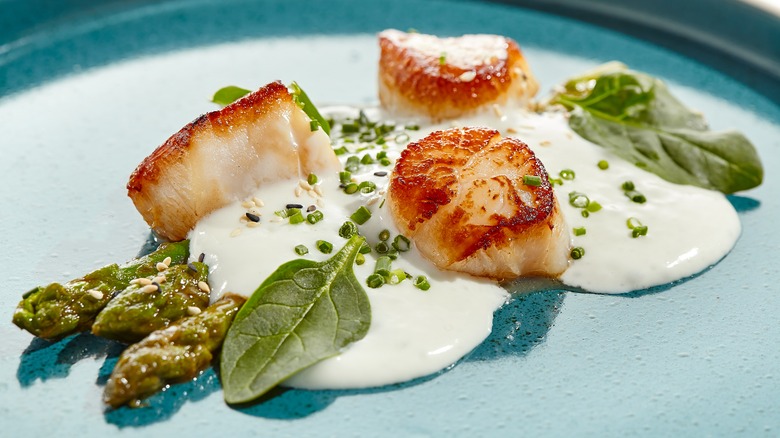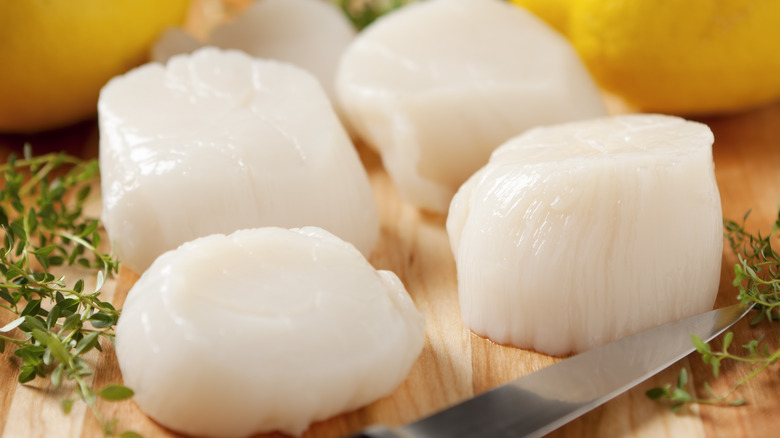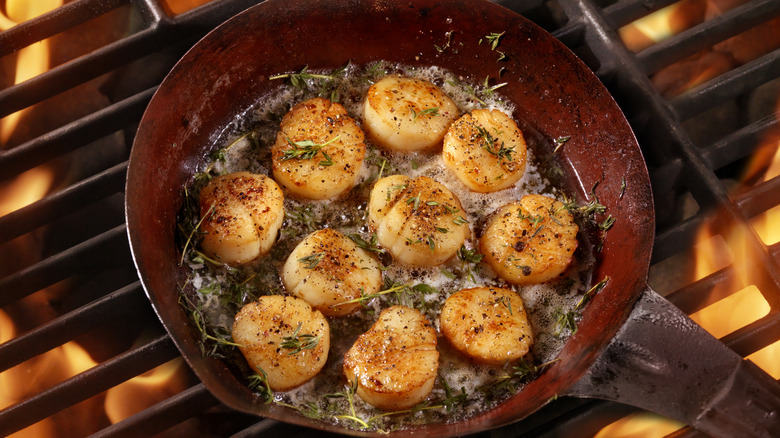Do You Really Need To Toss Scallops In Flour Before Cooking?
Few entrées are as impressive as perfectly browned and meltingly tender seared scallops. When cooked properly, these mollusks offer an incredible array of sweet, briny, and buttery flavors, but their delicate nature can be tricky to work with. To maximize the taste and texture of these shellfish, many chefs recommend coating scallops in flour in order to get a better sear.
While some cooks swear by this method, you actually don't have to cover your scallops in flour to get great results. In many recipes from sautées to stir-fries, meat and seafood are covered in flour or another powdery starch to aid in the caramelization process when they meet a hot pan, since starches tend to crisp up much faster than proteins do. Most cooks employ this method for stews and braises, such as when searing beef before making beef stew. However, its benefits for scallops are debatable.
Scallops tend to overcook rather easily due to their small size, and using flour can help avoid this pitfall, since it helps them develop a crust faster, meaning less time in the pan. However, this trick isn't so friendly for gluten-sensitive folks, and it can actually downgrade the taste of your scallops. The good news is that you shouldn't need this trick if you dry your scallops properly before placing them in a heated pan.
Dredging scallops in flour can negatively impact their taste
While flour might seem like a good ingredient to add a great crust to your scallops, it comes with downsides. When you add too much starch to the exterior of the scallops, you run the risk of masking the seafood's flavors with the taste of flour. Depending on the heat level of your pan, you could even end up with bits of raw or burnt flour in your food. Scallops have a delicate taste and mouthfeel, not to mention they're expensive, so the last thing you want to do is muffle their best qualities or even introduce "off" flavors into your dish.
There are a few things you should keep in mind if you want to employ the flour technique. First, only sprinkle in a minimal amount onto your scallops, as you don't want to overwhelm them. Secondly, try to use this method for dishes that will drench the scallops in a sauce. Any leftover starch on the pan or the surface of your seafood can be used to thicken the sauce, while the sauce simultaneously gets rid of excess starch on the scallops themselves. However, if you're enjoying scallops all on their own, it's best to forget the flour and follow a few other tips for seared scallop success.
Crank up the heat to get a better sear on your scallops
You may have a lot of questions about making scallops, and one fact that can calm your nerves is that scallops can (and absolutely should) be cooked for a short time. Hot and fast cooking is the name of the game. Regardless of whether you buy wet or dry scallops, your pan should be quite hot, so a crust can properly develop on the scallops in just a minute or two. And before you even put the scallops in the pan, pat them dry with paper towels. Make sure their exteriors are as dry as possible, without squishing them, as moisture is the enemy of browning, and scallops can sometimes be a bit wet straight out of the packaging.
Much like any other protein, you'll want to avoid filling your pan to capacity with scallops. Even after patting them dry, these delicious mollusks still release juices in the pan, and if the pan becomes full of liquid, they'll steam instead of searing. Scallops should be cooked in batches so that they'll brown properly, but remember to remove them at the right time, as well. Overcooked scallops feel like rubber, so you'll want to keep an eye on them and don't look away to avoid burning or overcooking them.



